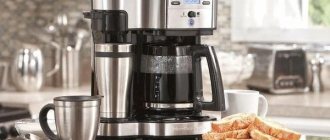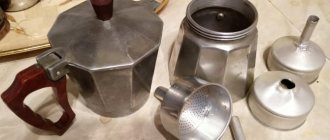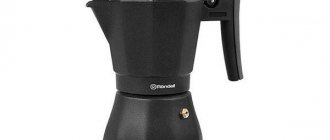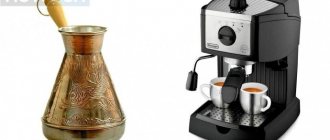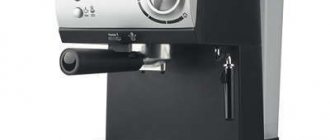To prepare real strong espresso, a special technology is used in which the beans come into contact with hot water, passed under pressure. This allows you to achieve the most complete extraction, preserving all the aromatic and taste qualities of coffee. This method of preparation is reflected in the operation of a carob coffee maker, which allows you to quickly prepare a high-quality drink.
What does a carob coffee maker mean?
Many users do not fully understand what a carob coffee maker is. At its core, it is a coffee machine for preparing coffee in a special way. The design includes a horn or holder with a handle designed for placing ground grains. Single- and double-horn devices are known, differing in productivity and volumes of the finished drink. A device with one cone dispenses no more than two cups, while models with two cones are used in offices and other places with a large number of people.
These coffee makers have the following technical characteristics:
- Pressure. Created inside a filter container filled with coffee powder. In different coffee machines this figure ranges from 2-6 to 8-9 bar. To achieve such performance, the pump develops a higher pressure - approximately 15 bar.
- Type of coffee. Usually a ground product is used, which is compacted tightly after filling. The high density of the powder retains water and ensures the most complete extraction of useful substances.
- Cappuccino maker. Installed in every device. Its design is made in the form of a tube with a nozzle installed at the end. Hot steam is supplied through this nozzle. Cappuccino makers can be manual or automatic.
- Volume. The quantity of the finished product depends on it. Most devices have small volumes, since espresso portions are very small - 25-35 ml.
- Heater. Structurally, it is a container within which a heating element is located. In simple coffee makers, this is the water tank itself, while in more complex and expensive ones, special thermal blocks are installed.
Different models are equipped with automatic decalcification, an anti-drip system, temperature control and hot water portions. A timer and other useful functions can be set.
Additional functions
Carob-type coffee cups may have additional options:
- An indicator that indicates the presence or absence of liquid.
- Overheating protection available.
- An additional pump with which you can prepare two types of coffee at once, which is good for a family where people prefer different types of this aromatic drink.
- A button that allows you to stop making coffee if necessary.
- The presence of an automatic heating option is necessary when coffee is prepared in advance.
- Heating cups - this function is quite rare and is equipped with expensive models of coffee machines. Note that this option can be replaced by a microwave oven.
Types of carob coffee makers and coffee machines
There are two main types of carob-type coffee makers. They are divided according to the principle of operation associated with heating water and passing it through coffee powder. This is where they got their names - steam and pump.
Features of steam coffee machines
This type of coffee maker is distinguished by its simplest design. The water in the sealed chamber is heated to boiling point. Steam is formed, creating a pressure of approximately 4 atmospheres. The water that has not turned into steam rises up the tube under pressure and ends up in a container with ground coffee. Passing through the powder, it absorbs aromatic, flavoring and other beneficial substances. At the end of the day, the drink is completely ready for consumption.
The nuances of brewing coffee
Carob coffee makers of any type cannot be classified as conventional coffee machines; there are differences. This involves manual preparation of drinks. You need to buy ground coffee or grind the beans yourself, then place everything in the filter, install the horn, and start the feed. Then all that remains is to throw away the used cake and rinse the equipment.
Obtaining results involves performing a few simple steps after turning on the coffee makers.
- Warm up.
- The entire group, the horn, is poured with high-temperature water.
- Wait a few minutes for the boiler to warm up.
Otherwise, temperature uniformity cannot be guaranteed.
A separate burr coffee grinder is necessary for those who choose mid-range devices. This is more important than just choosing the right class.
Freshness of grinding and roasting is important for any coffee.
In second place among other indicators is grinding, which was correctly chosen depending on a particular type of grain. In the case of pseudo-burr and rotary devices, it basically does not meet current standards.
If some time has passed and the owner is already accustomed to selecting grains and using the coffee grinder correctly, you can take a closer look at more advanced equipment. It is better to practice a little more on the old model, and then purchase a new one.
Even when using simple filters without additional functions, the most important thing of all conditions is to form the tablet correctly and select the grind. It is the tablet that is directly related to the creation of the required level of pressure in the chamber.
You can give additional advice to those who want to get better results.
- It is better to choose fresher grains. Grinding must also meet this requirement.
- With a burr grinder, the correct grind is very important.
- The same applies to the correct tamping of a coffee tablet, for which a metal tamper is used.
- After switching on, it is recommended to warm up the device for several minutes. Then pour the horn and filter without coffee and repeat the warming up procedure.
- Espresso coffee is poured only when the indicator lights up indicating the drink is ready.
- There is always a limit for storage type boilers; this is 60 ml for a one-time drink supply. The next portions of coffee are served after a few minutes of warming up. Coffee makers with thermoblocks make this requirement less relevant.
Operating principle of a carob coffee maker
In most coffee makers, the drink is prepared by mixing ground beans and hot water. The horn device works completely differently. The coffee powder is placed in a holder and pressed. Next, water vapor or water heated to a high temperature passes through this mass under high pressure. During its passage, it absorbs all the useful substances and ends up becoming a delicious aromatic drink.
This is a general scheme of operation, which may differ depending on the type of coffee maker - steam or pump. In both cases, the coffee comes out without impurities and is prepared quickly and efficiently.
What drinks can you prepare?
The main drinks prepared in a coffee machine are espresso and cappuccino. Also available:
- Latte, which differs in different proportions of milk and the way it is poured into the glass.
- Americano with double water. Can be prepared with warm or cold milk. Essentially - diluted espresso.
- Glace – espresso or Americano with the addition of ice cream.
- Irish coffee - double strong espresso with cream and alcohol - Irish whiskey.
Medium-ground green coffee, loose or in pods, is also suitable for extraction. Its strength decreases slightly when prepared using the espresso method, but the caffeine is noticeable.
How to choose a carob coffee maker for your home
There are a large number of models of this type, therefore, many users experience certain difficulties when choosing. Experts recommend not focusing on the brand and cost of the device. The main attention should be paid to the design and the presence of additional functions.
Externally, each coffee maker is very similar to its counterparts. Their designs are also approximately the same. But for your home, it is better to purchase an inexpensive steam-type device designed for small portions. A pump coffee maker with a large reservoir and high performance is recommended for the office.
How to use a carob coffee maker
The operating principle of these devices underlies their practical application. Regardless of the type of coffee maker, all actions are performed in a certain sequence:
- You should prepare purified or bottled water in advance. Regular tap water spoils the taste of the drink and contributes to the formation of scale.
- Grind the required amount of coffee, since only coffee machines are equipped with a built-in coffee grinder, and even then not all.
- Coffee is poured into a cone and pressed to the most dense state. Dust from the powder should not get into the threads.
- The filled holder is installed in its place.
- The device turns on and the cooking process begins. All you have to do is wait for the finished drink.
- If desired, you can use a cappuccino maker and create milk foam. It is added on top after milk is poured into the finished espresso.
Reviews
- Valeria . I brew coffee by hand or use my old drip coffee maker. I'm not a big fan of this drink, but it suits me. If I decide to buy a serious device, I will definitely listen to the advice.
- Ruslan . I highly recommend not purchasing middle-class carob coffee makers. The coffee in them does not taste very good, the plastic greatly affects the quality. It's better to overpay a little and get a normal model.
- Evgenia . Due to my active lifestyle, I have to drink only instant coffee - there is no time to brew. I liked the model from Kenwood and will buy it for my birthday.
Carob coffee makers care
Timely cleaning is the key to long-term operation of any coffee maker. Clean and well-maintained equipment keeps the taste of the drink at a high level.
First of all, the coffee oils remaining after brewing are removed. They are the ones who create a beautiful foam, but when deposited on the parts they spoil the taste of the coffee, making it rancid. Another serious problem is scale. It gradually forms even from clean water, disrupts the operation of mechanisms and can lead to premature failure of even the most powerful coffee maker. Finally, milk residues settling in the cappuccino maker tube cause the appearance and development of pathogenic microorganisms.
Not every carob coffee machine supports automatic cleaning. Therefore, the following activities are regularly carried out manually:
- After each preparation, the cone is rinsed with clean running water.
- The milk frother can be cleaned with a dry cloth. If dried dirt has formed, it must be removed, soaked in a cleaning agent and then rinsed thoroughly.
- The horn must be cleaned monthly with special cleaning tablets. They are placed instead of powder, after which the coffee machine needs to be put into operation. The shutdown occurs immediately after the water supply starts. The contaminants dissolve in about 15 minutes, after which the device is turned on again to rinse the horn with water. The device is considered cleaned when at least two liters of water come out.
- Scheduled decalcification is performed approximately once a year. To remove scale, use special products recommended by the manufacturer.
Malfunctions of carob coffee makers
Getting used to using a coffee maker every day, every coffee lover experiences serious discomfort if the device malfunctions. But don’t despair, since many breakdowns can be fixed on your own. Let's consider possible malfunctions and ways to eliminate them.
With normal care, the horn device lasts a long time and rarely breaks. However, sometimes it does happen and looks like this:
- The water supply has stopped. You need to immediately check its presence in the tank. The filter may be dirty and the float indicating the water level may be faulty. First of all, you need to clean the internal elements of debris and scale.
- The water does not gain temperature and the coffee turns out warm. Check the settings and repeat the cycle again if necessary. This happens during long periods of downtime.
- Water flows out from under the horn. Most often, it is enough to clean the sealing ring from coffee residues and other contaminants. It may need to be replaced. If the ring is normal, you need to clean the filter in the horn.
- The finished drink flows out in the form of a thin stream with a whistle or hiss. The filters will most likely need cleaning. If there is automatic cleaning, perform it completely, and clean the removable parts manually.
- The power indicator is on, but cooking has not started. Check the installation of all components, as well as the buttons for sticking. If the machine does not work, you will have to contact the services of specialists.
Features of the brewing group, horn
The brewing group is responsible for extraction. A horn with a filter can also be attributed to this part of the system. These are additional elements whose main purpose is to improve the quality of the finished product.
In the case of cheaper models, the horns are made of plastic. Other devices use only metal.
The filter is one of the key elements that directly affects the quality of the drink. It is also called a basket or portafilter.
The simplest filters from a design point of view are produced, but they place the most demands on the users themselves. In this case, the coffee flows “as is”; no additional manipulations are required. The filter looks like a regular type of fine mesh. During cooking, it is important to tamp the coffee well, choose the degree of grinding, and so on.
But modern models, including those for home use, are increasingly equipped with devices and systems that correct the owner’s mistakes.
Here are just some of the options that you may encounter in practice:
- With a double bottom and many holes.
- Multilayer filters with mesh.
- With the addition of springs that open the coffee supply at a certain level of pressure in the horn.
Such devices automate the process and protect the user from his own mistakes. But it is almost impossible to interfere with the process.
The easiest way to consider such an indicator is the diameter of the horn. Here it is enough to adhere to the principle “the more the better.” 58 millimeters is called the classic indicator for the professional class. It will be easier to buy sets of filters that complement the functions of the device. 50-54 millimeters will be the diameter of home products.



